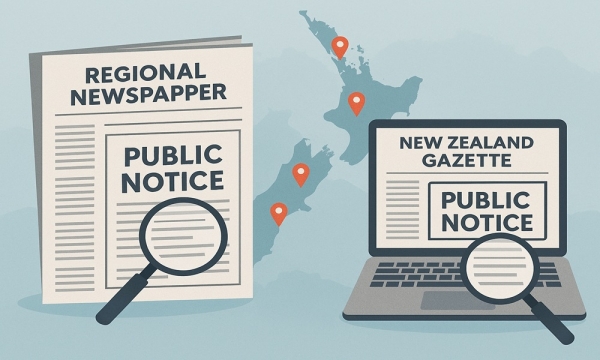Where do you look for public notices? If your answer is the NZ Herald, The Post or another regional paper, you’re not alone but you might miss the bigger picture.
We publish public notices every week for new insolvency appointments. It’s not optional, it’s a legal requirement under the Companies Act 1993 and other relevant legislation depending on the type of appointment. These notices serve an important purpose: they inform creditors, shareholders, and other stakeholders about key developments like:
- New insolvency appointments
- Opportunities to file claims in insolvency engagements, corporate and personal
- Meetings of creditors
- Watershed meetings
- Creditors taking enforcement action against companies and individuals
- Notices to end appointments
These notices are a critical part of the insolvency process. They ensure transparency, give affected parties a chance to respond, and help maintain the integrity of the process. But here’s the catch: if the notice doesn’t reach the right people, it’s not doing its job.
We had a situation that highlighted the importance of where these notices are published. We advertised an appointment in the New Zealand Gazette a few days before it appeared in the NZ Herald. The Gazette notice went live, and… silence. But once the regional ad ran, creditors started reaching out requesting claim forms and providing evidence to assist the liquidators.
It got me thinking why the delay.
The Reach Problem
The NZ Herald is a regional paper. It’s great for Auckland, but what about creditors in Christchurch, Wellington, or Invercargill? Businesses aren’t confined to one city. Suppliers and customers operate nationwide. If you’re only checking your local paper, you’re potentially missing notices that affect you.
Understanding the Difference
Let’s break it down:
New Zealand Gazette
- Nationwide coverage: It’s the central source for all public notices in New Zealand.
- Official status: It’s the government’s formal record.
- Searchable archive: Notices are easy to find and reference.
- Timely publication: Listings often go live faster than print media.
Regional Newspapers (e.g., NZ Herald, The Post, etc.)
- Local reach: Great for targeting a specific geographic audience.
- Print and digital formats: Useful for readers who prefer traditional media.
- Limited scope: Notices are usually region-specific and may not be seen by stakeholders outside the area.
Why It Matters for Stakeholders?
Insolvency Practitioners are required to give notice. But more than that, we want affected parties to be informed. If a creditor doesn’t see a notice, they might miss their chance to file a claim or attend a meeting. They may continue to trade with a customer and allow their account to be used when it should have been closed. That’s not just inconvenient, it can be costly. And for Insolvent Practitioners, it can mean delays, disputes, or even legal challenges.
Best Practice: Use Both Platforms.
As at the date of writing this article July 2025 the Companies Act 1993 says that Public Notices should be advertised in both the Gazette and a newspaper circulating in the area in which is situated (section 3). There has been discussion of Companies Act reform that will change the advertising requirements, with the decline in newspaper distribution the move online newspapers, the requirement for notification through newspapers will be removed. The same information will remain online through The Gazette.
Beyond Insolvency: Public Notices in General
While this article focuses on insolvency, the same principles apply to other types of public notices changes to company structures, statutory declarations, land transfers, and more. The Gazette is the central hub for all of these, and it’s free to access.

